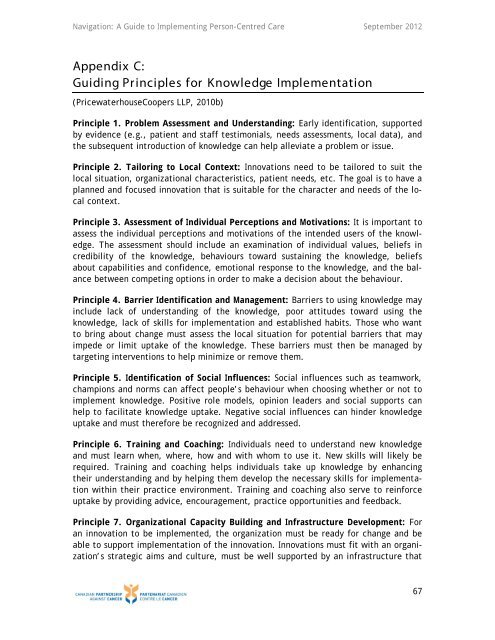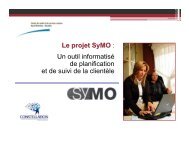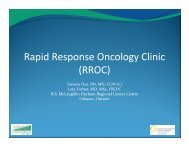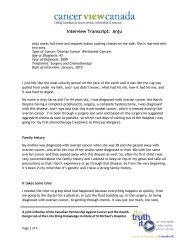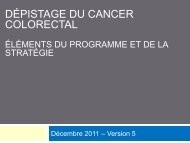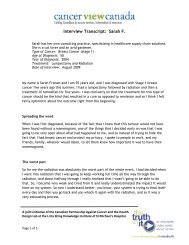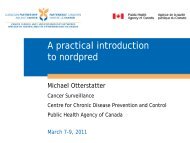A Guide to Implementing Best Practices in Person ... - cancerview.ca
A Guide to Implementing Best Practices in Person ... - cancerview.ca
A Guide to Implementing Best Practices in Person ... - cancerview.ca
Create successful ePaper yourself
Turn your PDF publications into a flip-book with our unique Google optimized e-Paper software.
Navigation: A <strong>Guide</strong> <strong>to</strong> <strong>Implement<strong>in</strong>g</strong> <strong>Person</strong>-Centred Care September 2012Appendix C:Guid<strong>in</strong>g Pr<strong>in</strong>ciples for Knowledge Implementation(PricewaterhouseCoopers LLP, 2010b)Pr<strong>in</strong>ciple 1. Problem Assessment and Understand<strong>in</strong>g: Early identifi<strong>ca</strong>tion, supportedby evidence (e.g., patient and staff testimonials, needs assessments, lo<strong>ca</strong>l data), andthe subsequent <strong>in</strong>troduction of knowledge <strong>ca</strong>n help alleviate a problem or issue.Pr<strong>in</strong>ciple 2. Tailor<strong>in</strong>g <strong>to</strong> Lo<strong>ca</strong>l Context: Innovations need <strong>to</strong> be tailored <strong>to</strong> suit thelo<strong>ca</strong>l situation, organizational characteristics, patient needs, etc. The goal is <strong>to</strong> have aplanned and focused <strong>in</strong>novation that is suitable for the character and needs of the lo<strong>ca</strong>lcontext.Pr<strong>in</strong>ciple 3. Assessment of Individual Perceptions and Motivations: It is important <strong>to</strong>assess the <strong>in</strong>dividual perceptions and motivations of the <strong>in</strong>tended users of the knowledge.The assessment should <strong>in</strong>clude an exam<strong>in</strong>ation of <strong>in</strong>dividual values, beliefs <strong>in</strong>credibility of the knowledge, behaviours <strong>to</strong>ward susta<strong>in</strong><strong>in</strong>g the knowledge, beliefsabout <strong>ca</strong>pabilities and confidence, emotional response <strong>to</strong> the knowledge, and the balancebetween compet<strong>in</strong>g options <strong>in</strong> order <strong>to</strong> make a decision about the behaviour.Pr<strong>in</strong>ciple 4. Barrier Identifi<strong>ca</strong>tion and Management: Barriers <strong>to</strong> us<strong>in</strong>g knowledge may<strong>in</strong>clude lack of understand<strong>in</strong>g of the knowledge, poor attitudes <strong>to</strong>ward us<strong>in</strong>g theknowledge, lack of skills for implementation and established habits. Those who want<strong>to</strong> br<strong>in</strong>g about change must assess the lo<strong>ca</strong>l situation for potential barriers that mayimpede or limit uptake of the knowledge. These barriers must then be managed bytarget<strong>in</strong>g <strong>in</strong>terventions <strong>to</strong> help m<strong>in</strong>imize or remove them.Pr<strong>in</strong>ciple 5. Identifi<strong>ca</strong>tion of Social Influences: Social <strong>in</strong>fluences such as teamwork,champions and norms <strong>ca</strong>n affect people’s behaviour when choos<strong>in</strong>g whether or not <strong>to</strong>implement knowledge. Positive role models, op<strong>in</strong>ion leaders and social supports <strong>ca</strong>nhelp <strong>to</strong> facilitate knowledge uptake. Negative social <strong>in</strong>fluences <strong>ca</strong>n h<strong>in</strong>der knowledgeuptake and must therefore be recognized and addressed.Pr<strong>in</strong>ciple 6. Tra<strong>in</strong><strong>in</strong>g and Coach<strong>in</strong>g: Individuals need <strong>to</strong> understand new knowledgeand must learn when, where, how and with whom <strong>to</strong> use it. New skills will likely berequired. Tra<strong>in</strong><strong>in</strong>g and coach<strong>in</strong>g helps <strong>in</strong>dividuals take up knowledge by enhanc<strong>in</strong>gtheir understand<strong>in</strong>g and by help<strong>in</strong>g them develop the necessary skills for implementationwith<strong>in</strong> their practice environment. Tra<strong>in</strong><strong>in</strong>g and coach<strong>in</strong>g also serve <strong>to</strong> re<strong>in</strong>forceuptake by provid<strong>in</strong>g advice, encouragement, practice opportunities and feedback.Pr<strong>in</strong>ciple 7. Organizational Capacity Build<strong>in</strong>g and Infrastructure Development: Foran <strong>in</strong>novation <strong>to</strong> be implemented, the organization must be ready for change and beable <strong>to</strong> support implementation of the <strong>in</strong>novation. Innovations must fit with an organization’sstrategic aims and culture, must be well supported by an <strong>in</strong>frastructure that67


